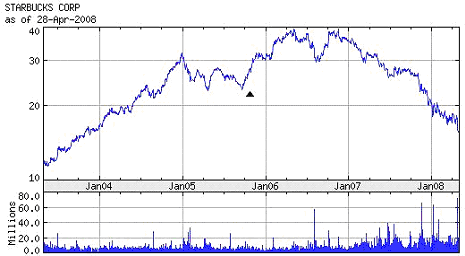July 04, 2008 – Business Strategy Article
A struggling Starbucks
Starbucks, the leading coffee retailer has been struggling amidst a faltering US economy, its own rapid growth and increased competition from cheaper rivals. In the first three months of 2008 its net income fell to $108.7m (£54.7m) down 28% from the same period of 2007. Its stock price has been falling steadily for the past two years (see exhibit 1). The stock has plunged more than 46% over the past year due to concerns about the weak economy and increased competition.

Exhibit 1: Stock performance graph of Starbucks for past five years (NASDAQ: SBUX)
Slowing down US Expansion plans
In July 2008, it announced closing of 600 of its stores (company-operated) across various locations in the U.S. Earlier, Starbucks had plans to shut only 100 of its stores, while 500 were on its internal watch list. Not great news for a company which revolutionized the coffee industry and transformed an everyday ordinary product into extraordinary business success. The reasons: Starbucks has struggled to maintain its differentiation in the face of growing competition. The company says its research shows it is not losing customers to competitors such as the privately-held Dunkin’ Doughnuts, but that consumers are simply not spending as much in Starbucks stores as they used to. The company had 125 stores when it went public in 1992, now has over 15,000 stores in 44 countries. The stores which are being closed are not profitable and are not expected to be profitable in future.
Starbucks forced to change strategy
Starbucks has always followed a strategy to blanket a region with its new stores. This means that by opening multiple stores in the same street or close by locations, it could reduce the customers’ rush in one store and also increase its revenues through new stores. This helped the company to reduce its distribution costs and the waiting time for customers in its stores, thereby increasing the number of customers. When a new store opens nearby, between 25 to 30% of revenue is cannibalized. Shutting down the stores would help return lost revenues.
Out of the 600 stores being closed, 70% had opened after start of 2006 which implies that Starbucks is closing down 19% of U.S. company-operated stores that opened in the last two years. Around 12,000 of its workforce will be affected by the closings.
Will Starbucks regain its past success?
Starbucks wants to turnaround its business by providing customers with the distinctive ‘Starbucks Experience’ and building on Starbucks legacy of innovation. Howard Schultz returned in early January 2008 as Chairman and Chief Executive and laid out several new “customer-focused” initiatives and a restructuring plan to restore an authentic coffeehouse experience back to its’ stores. Read
management case study (PDF file) on Starbucks’ Turnaround Strategy and restructuring plans. So will Starbucks be able to recreate its magic? Perhaps a recent news item that coffee can do more than just wake one up in the mornings and prevent auto-immune diseases such as lupus and rheumatoid arthritis (perhaps also cure multiple sclerosis) will help bring in more customers to Starbucks.
